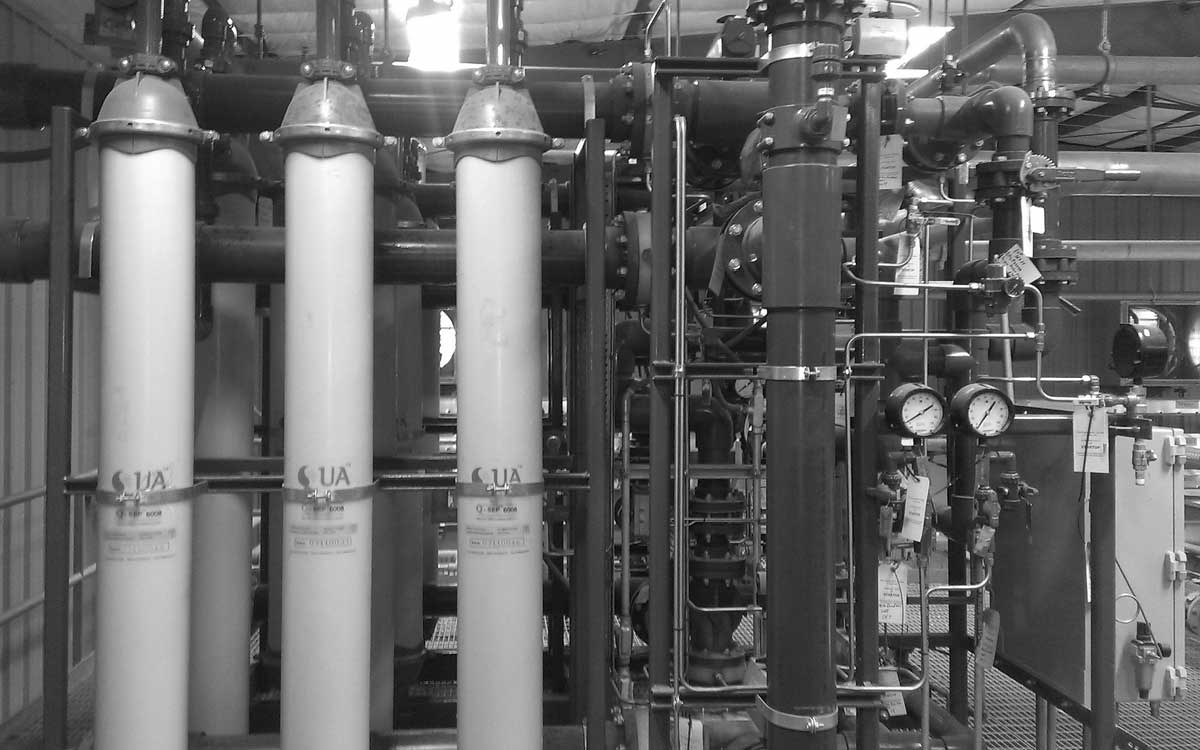About Q-SEP®
Ultrafiltration (UF) is a membrane process used to remove suspended solids, colloidal matter, high molecular-weight substances, and bacteria and viruses from various feed water sources. UF membranes can achieve a low and consistent silt density index (SDI) and are often used as pretreatment for reverse osmosis using surface water, seawater and biologically treated wastewater as feed source.
QUA Q-SEP® UF membranes incorporate high-strength, hollow fibers that deliver superior performance without the risk of fiber breaks. Q-SEP® UF membranes are available in inside-out and outside-in flow configuration. Both types of membranes have excellent low fouling characteristics. These hollow fiber membranes operate under a pressurized flow configuration for superior performance.
Q-SEP Technology

QUA Q-SEP® hollow fiber UF membranes offer reliable removal of turbidity, microorganisms, and viruses. Turbidity can be reduced to less than 0.1 NTU. Typically, a 6-log removal for bacteria, giardia and cryptosporidium, while a 4-log removal for viruses, can be achieved.
The fibers in the Q-SEP® module are held firmly in place, which reduces the stress on the fibers even at high flow velocities. Uniform fiber packing limits the pressure drop variation within the module and prevents localized high fouling conditions. The unique end cap sealing design allows for high pressure operation and ease of assembly. The Q-SEP® UF modules can be used as dead-end filtration or in cross flow mode.
The Q-SEP® inside-out modules contain an advanced UF fiber made from a modified polyether sulfone (PES) material. The fiber is prepared by a patented cloud point precipitation method. This method ensures a very uniform pore size distribution and high pore density in the membrane. As a result, the product water quality from the Q-SEP® modules is significantly better than the quality from conventional UF modules at a very low operating pressure. The membranes are available with 0.8 mm ID fibers, suitable for feed water turbidity up to 30 NTU.
The Q-SEP® outside-in hollow fiber ultrafiltration modules contain polyvinylidene fluoride PVDF membranes manufactured by QUA’s innovative modified thermally induced phase separation (TIPS) method. The membrane has high mechanical strength, high chemical and chlorine tolerance, and ability to handle high feed turbidity with wide range of application. The membranes are available with 1.25 mm (0.05 inch) OD fibers to treat feed water with high turbidity up to 300 NTU.
Advantages to Q-SEP:
| Features/Benefits | Value to Customer |
| Inside-Out – Patented Cloud Point Precipitation Process | Higher Quality Filtration Unique manufacturing process results in uniform pore size distribution on membrane surface resulting in consistently lower filtrate SDI. |
| Outside-In – Thermally Induced Phase Separation (TIPS) | Feed Water Flexibility Manufacturing process leads to high mechanical strength and the ability to address high turbidity wastewater. |
| High Porosity | Lower Capex or Lower Opex Can be operated at higher flux or lower TMP. |
| Lower Cleaning Frequency | Better Availability Q-SEP has superior fouling resistance properties. |
| Better Mechanical Integrity | Reliability Q-SEP has superior product design and mechanical integrity of components. |
Related Projects
- QUA Q-SEP® Ultrafiltration Technology Recycles Wastewater for Cooling Tower Make-Up Water in Leading Zinc-Lead-Silver Smelter ComplexRahim Shaikh2024-09-09T16:47:09+00:00

QUA Q-SEP® Ultrafiltration Technology Recycles Wastewater for Cooling Tower Make-Up Water in Leading Zinc-Lead-Silver Smelter Complex
- QUA’s Q-SEP® Ultrafiltration Membranes Effectively Treat Complex Effluent at Leading Integrated Steel PlantRahim Shaikh2024-09-09T16:47:19+00:00

QUA’s Q-SEP® Ultrafiltration Membranes Effectively Treat Complex Effluent at Leading Integrated Steel Plant
- Candor Business Park, Noida, IndiaMarketing Admin2024-02-02T05:44:34+00:00
Candor Business Park, Noida, India
- Coal Fired Power Plant, Raipur, IndiaMarketing Admin2024-01-30T12:27:59+00:00
Coal Fired Power Plant, Raipur, India
- Automobile Manufacturing Plant, Chennai, IndiaMarketing Admin2024-01-30T12:43:32+00:00
Automobile Manufacturing Plant, Chennai, India
- Ultratech Cement, Kolkata, IndiaMarketing Admin2024-01-30T13:01:49+00:00
Ultratech Cement, Kolkata, India
- Motorcycle Manufacturer, Tamil Nadu, IndiaMarketing Admin2024-01-30T13:00:17+00:00
Motorcycle Manufacturer, Tamil Nadu, India
- Coal Fired Power Plant, Chhattisgarh, IndiaMarketing Admin2024-01-30T13:03:27+00:00
Coal Fired Power Plant, Chhattisgarh, India








